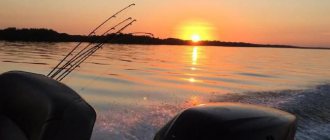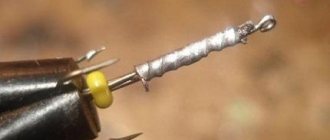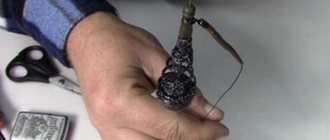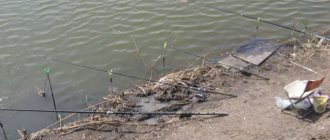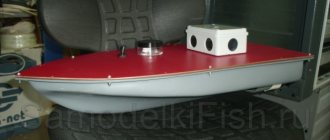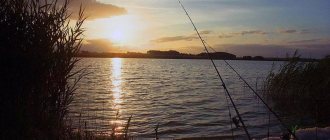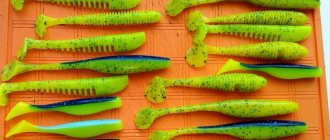Underwater camera setup for fishing
The principle of operation of such a device is quite simple: a sealed container with a built-in video camera and lighting diodes is lowered into the hole, which can be rotated, changing the viewing angle of the underwater world. The image is transmitted via cables to the monitor screen and makes it possible to observe how the fishing is going on. The battery is of great functional importance for providing the device with 12 V power, the charging of which must be given due attention for long-term operation.
Homemade options often do not have recorders for further review of video under water, but for the majority of amateurs this is not an important factor. If it is not possible to purchase a factory-made underwater camera, you can start creating a camera for winter fishing with your own hands from basic elements available at home or purchased at low prices.
DIY underwater camera assembly for winter fishing
As practice shows, there is nothing complicated about this. The main thing is the presence of all the main components, without which the video camera will not work underwater. To assemble it you will need the following components:
- Battery from a car.
- Sealed box.
- Extension cable.
- Inverter power supply.
- Miniature TV or modern video camera.
- Lead weight.
- LEDs for illumination (ultraviolet).
- High quality glue.
- Sealed material.
- Plastic container.
- Insulating tape.
OWN UNDERWATER CAMERA FOR 3 THOUSAND. RUBLES
The correct choice of some components is also important. For example:
- Video cameras should only be selected in small sizes. They will prove to be the most practical for the given conditions. At the same time, we should not forget about how high-quality its image is.
- The underwater box where the camera will be placed must be so sealed that not even a drop of water should get inside. In addition, its dimensions must correspond to the dimensions of the device.
Features and Requirements
An underwater fishing camera expands the technical capabilities of the fisherman, allowing him to see how the fish behaves, how it reacts to the bait, and develop the desired fishing strategy. But when choosing the constituent elements, you need to take into account their characteristics. A good sensitive video camera will provide a clear picture, while low-sensitivity options will produce blurry and cloudy outlines that will be difficult to see.
More often they choose video cameras that have a small viewing angle and two lenses. Models with a wide viewing angle are not suitable for underwater use due to poor picture quality. You need to make sure that the selected video camera has a light-sensitive matrix, anti-fog protection, night vision function and contrast adjustment function.
It is necessary to take into account the pressure when using a camera at great depths; in most cases, video cameras with an average immersion depth are used. In addition, the chamber must be so small that, together with the sealed housing, it can easily fit into the hole.
The presence of lighting is necessarily provided for in the design, but the lighting should not be excessive so as not to scare away the fish. Ultraviolet diodes are used for underwater observation. It is necessary to protect the lighting system from overheating and burnout, for which the circuit provides for the use of resistors. You can also purchase a camera with built-in LEDs.
A good TV screen is also of great importance: a clear picture is the main thing when creating a homemade design. The monitor must provide a high-quality image of the underwater process. For this purpose, portable televisions are widely used, when purchasing which you need to pay attention to companies from familiar manufacturers so as not to purchase a bad fake. Tablets and smartphones are also used.
Choosing the right video camera
A high-quality image underwater can only be obtained if you choose the right video camera. As practice shows, when choosing, you should pay attention to the following data:
- Sensitivity
. The higher the sensitivity, the clearer the image will be. If you use a low-sensitive video camera, you will get a cloudy, blurry image where it will be difficult to see anything. - Availability of backlight
. When filming underwater, where visibility is significantly limited, the presence of a backlight for a video camera plays a significant role in obtaining a high-quality image. But this does not mean that there should be a lot of light. This factor can scare away fish. - Permissible immersion depth
. As a rule, preference is given to cameras with medium immersion depth. The higher the immersion depth, the more pressure the device experiences. This means that the requirements for the waterproofing device will be high. - Visibility angle
. Video cameras with a wide viewing angle convey a worse picture. Basically, cameras with two lenses that have small viewing angles are selected. - Monitor capabilities
. It is very important that the size of the picture does not lose clarity when enlarged. Basically, this factor depends on the manufacturer who puts certain features into their product. - Manufacturer's fame
. As a rule, the more famous the manufacturer, the better the quality of its products. The fact is that these two concepts are interconnected. Today, many companies, in pursuit of profit, are trying to produce products similar to those that have been produced by world-famous companies for decades. Take, for example, the same Chinese who copy various models. Although they are far from real branded models in terms of quality and reliability. A quality product must be accompanied by a quality certificate. If this is not the case, then it is most likely a fake. - For camera dimensions
. The fishing hole is not so large. In diameter it does not exceed 100-130 mm. Therefore, the video camera should easily fit into this hole and be pulled out just as easily. And if you consider that it can be in a sealed box, then it’s not difficult to imagine what size the video camera should be. When purchasing a product, you should definitely test it for performance and measure its volume.
Schemes and materials for a homemade camera
When making a camera for winter fishing with your own hands, the following elements and materials are used:
- battery (power supply 12 V);
- TV monitor or LCD display with 12 V power supply;
- small video camera;
- LEDs and resistors for them;
- waterproof container;
- inverter for voltage conversion;
- AV output (tulip) for monitor;
- sealed shielded cable;
- lead weights;
- insulating materials (sealants, glue, insulating tape).
An alternative homemade option can be made from a smartphone, a camera, a USB and an OTG cable as a clamp. In this homemade product, the picture is transferred to the phone. Its advantage is that it works without a battery, but its disadvantage is the small image size.
Consumables and components
You can purchase components at the nearest radio market, in specialized auto stores or on a well-known Chinese online trading platform. In the latter case, you need to take into account the delivery time and the impossibility of quality control before payment.
Recommendations for choosing components:
- Monitor. You can take a car one with a screen size of 3.5 “. Preference is given to models with a fastening element - a platform.
- Camera. You can also use car, rear view. By default, it has a waterproof case, which can be improved by making an additional box. But this is done only as a last resort, as the image quality decreases.
- Cord for connecting the camera to the monitor. Its minimum length is 3 m. This is an ordinary three-core cable.
- Battery. Small in size, characteristics are selected according to the parameters of the monitor.
What pressure is better for fishing in summer and winter: high, low or normal?
The average cost of components is from 3,000 rubles and above. You can take used models, but with a preliminary performance check.
How to assemble a camera
After purchasing the necessary materials, you need to choose a suitable container for the video camera. You can take a food container with a closing lid, the main condition is the transparency of its walls with sufficient strength. Ultraviolet backlight diodes must be installed on one plate and protected with resistors from overheating. Connect all components to a low-current power cable, highlighting one core for image transmission.
Step-by-step instruction
- Connect the video camera to the monitor with a shielded cable, connect it to power and check the consistency of their operation.
- The cable should be strong but thin (it will take up less space when twisted, preferably KMM 4×0.12).
- Make two holes in the upper part of the camera container: one for connecting the camera to the monitor, the other for an extension cable.
- Make a hole in a plastic container for illumination and connect it to the power supply.
- Make weights from lead and place them at the bottom of the container.
- Connect the camera to the cable and place it strictly horizontally in the container, placing a soft base (for example, foam rubber) under it. The camera must be securely fixed.
- Connect the core of the power cable to the 12 V converter, and connect the core of the video signal to the monitor using a tulip connector.
- Connect the power cable to the battery.
- Check the operation of the camera with the TV a second time.
- Tie a rope of the required length to the container to lower/raise the container with the camera (you can make meter marks on it to determine the immersion depth). The rope can be connected to the cables with electrical tape.
How to protect from water
Particular attention should be paid to the tightness of the device. The underwater container for the camera, in addition to being transparent, must be so insulated that water cannot penetrate inside under any circumstances. All parts in contact with water must be reliably treated with sealant (usually silicone).
When the underwater chamber is assembled, you need to carefully treat all the holes in the container with insulating materials. For this purpose, special glue or silicone is used. Particular attention is paid to where the cables enter the camera box - they must be securely fixed so that their position is not disturbed during use.
It is important that the distance between the lens and the wall of the container is small, otherwise fogging occurs, visibility is impaired, and parts may fail. The tightness of the assembled device is checked not only for moisture resistance (for example, in the bathroom), but also for cold resistance by placing the structure in the freezer. If the device has passed the water test and has not cracked from the cold, you can try it out in ice fishing conditions.
Storage and transportation conditions
Creating a camera for winter fishing with your own hands does not end with assembling the main structure. It is necessary to select a suitable reel for the cable (in frosty weather the cable cannot be bent; it must be handled carefully). The cable wound on a reel can be conveniently placed in a special box (or suitcase) for transporting a homemade device.
A suitcase or box for an underwater camera needs to be equipped with nests, limited by rubber gaskets for separate placement of the monitor, container with a video camera and cable reel. All structural elements must be in a fixed position so as not to dangle during transportation. First of all, this concerns the container with the camera and the cables extending from it.
At home, the box with the device must be disassembled and all components of the structure must be thoroughly dried, after which you need to charge the video camera for the next fishing trip (or the day before it). It would be useful to additionally check the integrity of the areas treated with sealant. If the container's seal is broken, re-treat these areas with insulating materials.
Many fishermen advise making a special box with a window for the monitor - to conveniently install the TV on the ice and protect it from sunlight that interferes with viewing the image. Showing ingenuity in the manufacture of transport packaging, proper care and storage of a homemade underwater camera is the key to its long service life.
How to choose?
To buy a camera for winter fishing on Aliexpress and not make a mistake with your choice, consider the following criteria:
- maximum depth - if you fish mainly in large, deep reservoirs, then this parameter should be from 25-30 meters. In other cases, a cable of 10-15 m is enough;
- sensitivity of the matrix - the dirtier the water in a river or reservoir, the higher this parameter should be;
- viewing angle – this parameter determines how many objects will fall into the camera. Focus on average values, since the quality of shooting decreases as the viewing angle increases;
- Battery capacity – the larger the battery capacity, the longer the camera will work on one charge. If you often go fishing, choose models with high-capacity batteries.
of tents for winter fishing for you , there are quite good and inexpensive tent , and for those who need spinning rods in different price categories, our new selection is available, also read, write comments, it is important for us to know your opinion.

